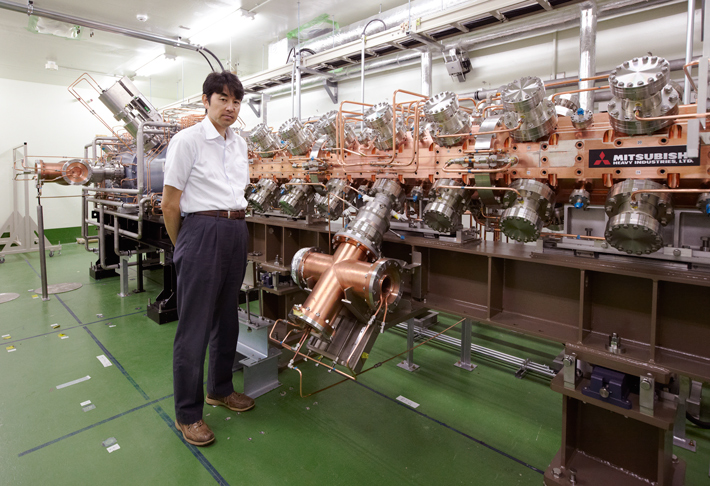TSUKUBA FRONTIER
#11 The Day Hospitals Will Run Particle Accelerators: A Cutting-edge Next-generation Cancer Treatment Made Possible by Neutrons
Difficult-to-treat sites and recurrence are constant challenges in cancer treatment, and have sparked interest in boron neutron capture therapy (BNCT). As a medical physicist, Professor Kumada is working to develop a particle accelerator for this therapy and connect with medical professionals to establish treatment methods.
Associate Professor KUMADA Hiroaki, Faculty of Medicine

■ Fast-acting neutron therapy
BNCT is a treatment that selectively destroys cancer cells with alpha rays and lithium particles produced by reaction between boron particles and neutrons. Patients are administered a boron-filled drug with properties that cause it to only accumulate in cancer cells. Once the drug is administered, the cancer cells take up boron, and are irradiated with neutron beams. The alpha rays and lithium particles produced in the cancer cells can only travel a distance of about 10 microns, which is exactly the size of a single cell. This means that they stop after damaging only the DNA of cancer cells, and have no effect on surrounding normal cells.
This treatment is particularly effective for tumors that are difficult to remove surgically, for example, malignant brain tumors and head and neck tumors. Unlike conventional radiotherapy using X-rays, BNCT can selectively attack cancer cells that are scattered throughout normal cells. When used to treat recurrence, it enables multiple rounds of radiotherapy to be performed without exceeding the maximum allowable radiation dose to normal cells.
In addition, conventional radiotherapy requires several radiation sessions over a period of more than one month, but BNCT only requires one radiation session of a few minutes even for patients with serious disease. BNCT has a very potent cytotoxic (cell-killing) effect, and causes cancer to start disappearing by about one month after radiation. BNCT is a highly effective breakthrough treatment that is less invasive and more convenient for patients.
■ Introducing particle accelerators to medical practice
Essential to BNCT is a device that can produce neutron beams. This device can be either a nuclear reactor or a particle accelerator. It is not feasible to use a nuclear reactor at present due to the difficulty of starting up and maintaining nuclear reactors after the Great East Japan Earthquake of 2011. Particle accelerators, on the other hand, can be installed at hospitals and do not require high-level radiation control, so they can be studied in clinical research and introduced to medical practice.
The device Prof. Kumada is developing is a straight particle accelerator about 7 m in length. Particle accelerators are typically used to observe subatomic particles or atoms, or to study the canonical structures of substances. For those applications, it is important that the device can produce a strong beam in just a moment. However, medical use requires a device that can maintain a stable beam of fixed intensity. Treatment parameters such as the angles and durations of beam irradiation to patients must also be determined. To do this work, Prof. Kumada must harness his expertise in the fields of medicine, physics, and engineering.

■ A center for both research and training
The principle of BNCT was first described in the 1930s, but it is only recently that technology has caught up enough to try and make it a reality. There are currently four institutions working on BNCT in Japan. A prototype device in the village of Tokai that is being developed by a team including the University of Tsukuba will soon be complete. The team plans to start clinical research after verifying neutron output and safety. If the treatment is approved through the drug approval process, it will be possible to offer as medical care.
To widely adopt this treatment, it will be essential to train staff to operate and use the particle accelerators. Medical physicists are the professionals qualified to do this job, but only about four of the several hundred certified professionals across Japan can perform BNCT. The University of Tsukuba also serves as a training center for medical staff to build experience using BNCT.
■ Combining the powers of medicine, engineering, and chemistry
Prof. Kumada originally specialized in software development, but learned about the new BNCT method while doing joint research at the Tokai reactor with the University of Tsukuba Hospital's medical team as an engineer. He then joined the University of Tsukuba faculty and started research in earnest. The more he saw patients cured by treatment, the more he was motivated to develop the particle accelerator.
BNCT can only become complete as a treatment through the combination of biological understanding of the properties of cancer itself, the technology utilizing neutrons and particle accelerators, and the development of effective boron-filled drugs that react with neutrons. The University of Tsukuba provides an excellent environment for this kind of collaboration to take place.
As more and more clinical data on BNCT are collected, pharmaceutical companies should become actively involved and propel the research forward in one big leap. Both doctors and engineers are passionate about paving the way to coverage of BNCT as an advanced medical treatment and as care covered under health insurance so that many people can benefit from it.
Article by Science Communicator at the Office of Public Relations


